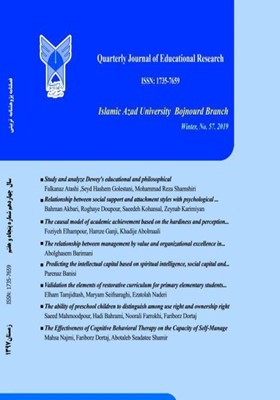-
-
List of Articles
-
Open Access Article
1 - The causal model of academic achievement based on the hardiness and perception of the classroom environment with the mediation of academic engagement
Fozieh Elhampour hamzeh Ganji Kadije Abolmaali Alhosani -
Open Access Article
2 - Relationship between social support and attachment styles with psychological well-being of university students
Bahman Akbari Roghaye Doupour Saeedeh Kohansal Zeynab Karimiyan -
Open Access Article
3 - The relationship between management by value and organizational excellence in Mazandaran Islamic Azad University
Abolghasem Barimani -
Open Access Article
4 - Predicting the intellectual capital based on spiritual intelligence, social capital and knowledge management in university students
Parenaz Banisi -
Open Access Article
5 - Validation the elements of restorative curriculum for primary elementary students with special disabilities in learning from the viewpoint of curriculum experts and relevant teachers in east Azarbaijan province
Elham Tamjidtash Maryam Seifnaraghi Ezatollah Naderi -
Open Access Article
6 - The ability of preschool children to distinguish among use right and ownership right
Saeed Mahmoodpour Hadi Bahrami Noorali Farrokhi Fariborz Dortaj -
Open Access Article
7 - The Effectiveness of Cognitive Behavioral Therapy on the Capacity of Self-Management, Deafness and Marital Engagement refereed to counseling centers
Mahsa Najmi Fariborz Dortaj Aboutaleb Seadatee Shamir
-
The rights to this website are owned by the Raimag Press Management System.
Copyright © 2021-2025







